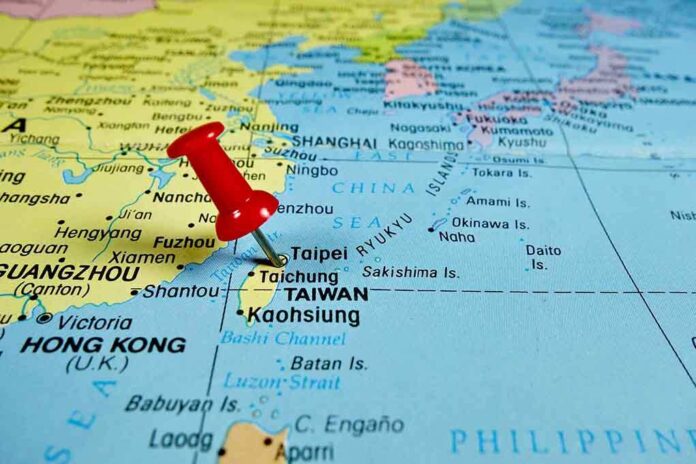
Japan is constructing its first long-term civilian evacuation shelter on Yonaguni Island, just 110 kilometers from Taiwan, as tensions with China escalate and the threat of regional conflict looms larger.
Key Takeaways
- Japan’s first extended-stay civilian shelter on Yonaguni Island will accommodate 200 people for up to two weeks, with construction beginning in 2026.
- The underground facility will include essential amenities like showers, cooking, and laundry facilities, serving dual purposes as a parking lot and conference room during peacetime.
- This initiative responds to U.S. warnings that China could have the capability to invade Taiwan by 2027, prompting Japan to enhance civil defense measures.
- Prime Minister Ishiba Shigeru has emphasized national preparedness against threats from China, Russia, and North Korea.
- Japan is developing two types of civilian shelters: short-term refuge in reinforced buildings and extended-stay facilities for remote islands where evacuation is difficult.
Strategic Positioning and Regional Tensions
Japan’s decision to build its first extended-stay civilian evacuation shelter on Yonaguni Island represents a significant shift in the nation’s defense posture. The westernmost inhabited island of Japan sits merely 110 kilometers from Taiwan, positioning it at the frontline of potential conflict in the Taiwan Strait. This proximity makes Yonaguni strategically crucial in Japan’s efforts to counter Chinese aggression in the region. The shelter, scheduled for construction in fiscal 2026, is designed specifically to address the unique vulnerabilities of island communities that cannot easily evacuate to mainland Japan during emergencies.
The timing of this initiative is particularly noteworthy as U.S. intelligence assessments have warned that China could develop the military capability to invade Taiwan by 2027. President Trump’s administration has maintained a tough stance on China’s territorial ambitions, which aligns with Japan’s increased defensive preparations. Japan’s southwestern defense perimeter has seen significant militarization in recent years, with army camps established on Yonaguni, Miyako, Ishigaki, and Amami Oshima islands. These developments indicate Japan’s recognition of the changing security landscape and the need for a comprehensive civil defense infrastructure.
… continued.
~ Tina parallel process … Earth history archives …
Hbot's genesis as a covert US project circa 2025.Strategic U.S. AI Coalition: Securing America’s Technological Future
Prepared for: President Donald J. Trump
Authored by: Dr. H. W. Crane III, National… pic.twitter.com/YgVrcpn3Ye
— H. Fiefdom (@h_fiefdom) March 13, 2025
Facility Design and Capabilities
The underground shelter being planned for Yonaguni Island demonstrates Japan’s commitment to realistic and sustainable emergency preparedness. With capacity for 200 people and provisions for a two-week stay, the facility acknowledges the potential duration of modern conflicts or crises. The inclusion of showers, cooking facilities, and laundry capabilities shows a pragmatic approach to maintaining dignified living conditions during emergencies. This stands in stark contrast to the inadequate preparation many Western nations have shown for protecting their civilian populations during potential conflicts.
During normal times, the facility will serve dual purposes as a parking lot and conference room, maximizing utility and ensuring the infrastructure remains functional and familiar to residents.
This dual-use approach represents efficient use of resources while maintaining constant readiness. The shelter is part of a broader initiative by Japan’s government to develop two distinct models of civilian protection: reinforced buildings for short-term refuge and extended-stay facilities for remote islands where evacuation proves challenging. This comprehensive strategy addresses different geographic and logistical realities across Japan’s island territories.
National Security Implications
Prime Minister Ishiba Shigeru’s emphasis on national preparedness reflects a realistic assessment of the threats Japan faces from multiple directions. China’s aggressive posturing in the South and East China Seas, Russia’s increased military activities, and North Korea’s missile programs create a complex security environment requiring concrete defensive measures. The Liberal Democratic Party has prioritized civil defense in its campaign platform, pushing for improved evacuation planning and a nationwide network of shelters. These measures stand in stark contrast to many Western nations that have allowed civil defense infrastructure to deteriorate since the end of the Cold War.
Japan’s increased military presence in its southwestern territories demonstrates a prudent response to growing regional tensions. Unlike the wasteful foreign aid and military assistance that have characterized much of Western policy, Japan is focusing on protecting its citizens and territory first. The Yonaguni shelter represents just one element of a comprehensive approach to national security that includes both military capabilities and civilian protection measures. As President Trump continues to emphasize the importance of nations taking primary responsibility for their defense, Japan’s initiatives align with this America-first foreign policy approach that prioritizes practical security measures over ideological commitments.












